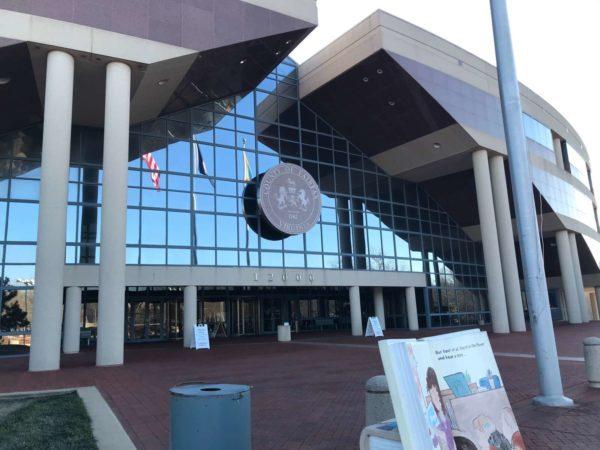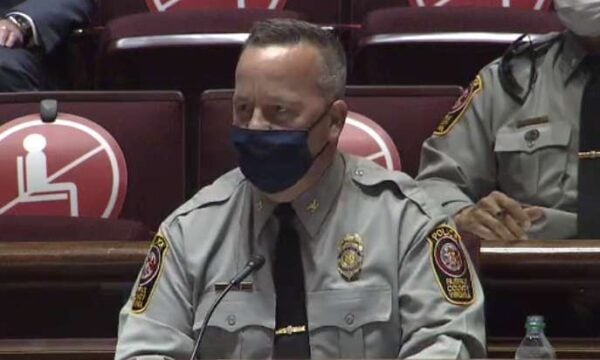
Abandoned shopping carts can create problems and even be left in streams, but a new state law seems to provide little help, Fairfax County supervisors say.
During a land use policy committee meeting yesterday (Tuesday), the Board of Supervisors reexamined a Virginia law intended to discourage people from taking shopping carts away from businesses, worrying that introducing a local ordinance might just add an exhaustive and ineffective process.
“What we’re asking of our investigators is extraordinarily time-consuming and fruitless,” Braddock District Supervisor James Walkinshaw said of the draft abandoned shopping cart ordinance.
A leading concern is that adding an ordinance may take up time and put an unnecessary administrative burden on county staff, who could, for example, document the same incident twice since the state law dictates that a cart’s owner get a 15-day notification period before it can be removed.
Currently, if a cart is blocking a road or a group is cleaning up a stream, there is no restriction on removing it.
The Virginia General Assembly passed a law in 2020 to allow counties to pass legislation to:
- Fine people with a civil penalty up to $500 for removing shopping carts from stores’ premises and parking lots
- Make stores liable for returning or disposing of abandoned carts, including paying up to $300 per cart that the county removes
The land use policy committee discussed the issue in December, though staff advised against adopting an ordinance and board members were skeptical. During the meeting, Chairman Jeff McKay voiced opposition to fining people trying to get groceries home.
The draft ordinance that the county presented on Tuesday only referenced fines for businesses — not individuals.
Even before the 2020 state law, the Commonwealth made removing shopping carts from store premises and parking lots a misdemeanor, with the potential for a fine up to $500.
“My problem with this is…it provides absolutely no incentive for people to stop stealing carts,” said Springfield District Supervisor Pat Herrity, who also wondered if certain areas or customers might be disproportionately affected. “This is kind of outside the businesses’ control.”
Photo via David Clarke/Unsplash
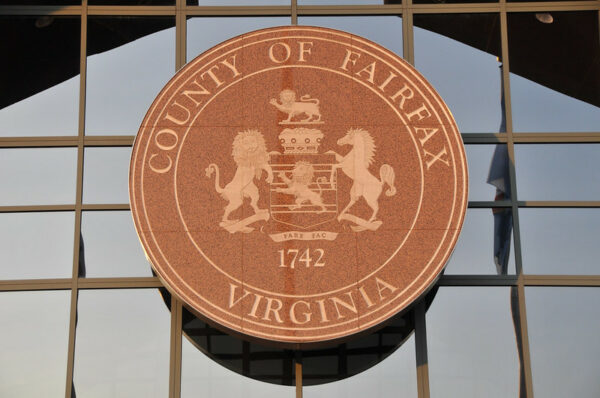
Fairfax County could send over $24.4 million in federal money to small businesses recovering from the COVID-19 pandemic through its PIVOT grant program.
The money, which doesn’t have to be repaid, is intended to help economic recovery efforts. After an application period ran from June 23 to July 9, county officials gave updates on the program to the Fairfax County Board of Supervisors during an economic initiatives committee meeting this morning (Tuesday), stressing the timing and scope of the support.
“Our retail services and amusements businesses really did need this funding,” said Theresa Benincasa, economic mobility manager with the county’s Department of Economic Initiatives. “They stepped up and requested it in large numbers.”
Nearly 1,600 applicants for Fairfax County’s small business PIVOT grant program are eligible to get the money based on an initial eligibility check, while 921 applicants are ineligible, county staff reported.
During the meeting, Board of Supervisors Chairman Jeff McKay asked if the county had flexibility on an eligibility requirement that a business have a commercial storefront. He said two businesses approached him about the issue, one of which was a catering business tied to a closed office building.
Benincasa said officials could work with him on that issue.
Most of the applicants that were ineligible didn’t meet the threshold for economic injury. Over 300 didn’t have a commercial storefront, and nearly 200 secured a Small Business Administration Restaurant Revitalization Fund grant, which provided $283,000 on average, according to the county.
Recipients had to have at least a 15% loss in annual revenue. Eligible applicants averaged a 46% reduction in revenue and 25% reduction in employees, according to county data.
Benincasa noted that applications are still moving through a three-step process to obtain the money. The first step involved using a web portal to determine initial eligibility, and the remaining steps could last from August to November.
The grants are being funded with $25 million that the county received from the American Rescue Plan Act. If demand surpassed that threshold, the county had prepared to prioritize funding to hotels and then create a lottery system for other applicants, but because it didn’t, that randomization element will be scrapped, the county said Tuesday.
The breakdown of awards is projected to be the following:
- $14.1 million to 1,178 applicants with an average of four employees in the areas of retail, services, and amusements
- $5.4 million to 309 applicants with an average of eight employees in the food service sector
- Nearly $4.5 million to 61 applicants with an average of 25 employees in the lodging sector
- $415,000 to 49 applicants with an average of four employees in the areas of arts organizations, museums, and historical sites.
The awards range from $1,500 to $18,000 per business, which all had to have 500 employees or fewer.
Hotels could receive $400 per room if they had 10 rooms or more. In January, the American Hotel and Lodging Association released a report on the “sharp and sustained” drop in travel due to COVID-19 in 2020 and projected that the travel industry won’t fully recover until 2024.
Benincasa said that most of the hotels in the county are getting PIVOT money, but that didn’t include all of them, possibly because of the 500-employee cap.
“The need is immediate,” said Dranesville District Supervisor John Foust, who chairs the economic initiatives committee, noting the county’s work isn’t finished in helping small businesses.
Photo via Machvee/Flickr
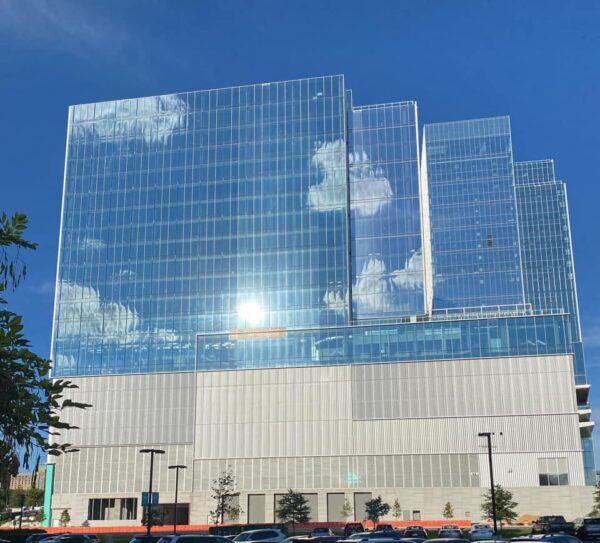
Virginia Expected to Lift Mask Requirement in Schools — Virginia is reviewing updated federal guidance saying that in-person learning should be prioritized even if not all mitigation strategies can be adopted. The Centers for Disease Control and Prevention says masks should still be worn indoors by anyone not fully vaccinated, especially when social distancing isn’t possible. [Richmond Times-Dispatch/Danville Register & Bee]
Fairfax County Police Investigate Herndon Stabbing — A dispute between “three juvenile acquaintances” on July 3 in the 2000 block of Huston Place resulted in one of the individuals stabbing another in the upper body. The victim was taken to a hopsital for injuries that were not life-threatening. [FCPD]
New County Public Works Director Begins Job — Starting today (Monday), the Fairfax County Department of Public Works and Environmental Services has a new director, as Christopher Herrington succeeds Randy Bartlett, who retired in June. Herrington’s past experience includes serving as senior environmental policy officer for the City of Austin in Texas. [Fairfax County Government]
Herndon Police Chief Appointed to State Board — Herndon Chief of Police Maggie DeBoard has been appointed to Virginia’s Forensic Science Board, one of several new appointments announced by Gov. Ralph Northam on Friday (July 9). The Department of Forensic Science provides laboratory services to law enforcement agencies, prosecutors, medical examiners, and other agencies that conduct criminal investigations. [Office of the Governor]
Photo via Sam Moon Sami/Facebook

The Fourth of July is coming up this weekend, and with Monday (July 5) as a designated federal holiday, many public facilities and services will be shaking up their schedules.
The Fairfax County Health Department announced today (Friday) that all of its COVID-19 vaccination clinics will be closed on Independence Day, but walk-in services will be available at the Fairfax County Government Center and the former Safeway at Mount Vernon Square in Alexandria on Saturday.
A vaccine site at Springfield Town Center will also be open for walk-ins on Monday.
Here are some other closures that county residents should keep in mind this holiday weekend:
Fairfax County Government
- County government offices will be closed on July 5th
Fairfax County Courts
- The Fairfax Circuit, General District, and Juvenile and Domestic Relations District courts will be closed all day on July 5.
County Libraries, Recreation Centers, Parks
- All Fairfax County library branches will be closed.
- All Fairfax County RECenters will operate at their regular hours.
- Colvin Run Mill, Sully Historic Site, Hidden Oaks, Hidden Pond, E.C. Lawrence and Huntley Meadows nature centers will be closed.
- The Riverbend Park visitor center will be open from 9 a.m. to 5 p.m.
- Green Spring Garden’s horticultural center and historic house will be closed.
Public Transit
- Fairfax Connector buses will operate on a Saturday service schedule on Monday. Check the link for details on specific routes.
- WMATA Metrorail service will operate from 7 a.m. to 11 p.m. on Saturday and 8 a.m. to 11 p.m. on Sunday. Details on routes and closed stations can be found on the Metro website.
- WMATA Metrobus will operate on a Saturday service schedule on Monday.
County Trash and Recycling
- There will be no change in the county’s trash and recycling collection.
- The recycling and disposal centers at the I-66 Transfer Station and I-95 Landfill Complex will be closed.
Reston
- The Reston Community Center Hunters Woods will open from 9 a.m. to 2 p.m on Sunday and 9 a.m. to 9 p.m. on Monday.
- Reston Community Center Lake Anne will be closed all day Sunday and Monday.
- All Reston Association offices, including the central services facility and the Walker Nature Center’s Nature House, will be closed on July 5.
Herndon
- Town offices and the Herndon Community Center will be closed on Sunday and Monday.
- Recycling will be collected on Monday as normal.
- The farm at Frying Pan Park and the indoor arena will be open, but the visitor center will be closed.

Fairfax County is continuing its efforts to transition to renewable energy with the installation of solar panels on county government and public school buildings, but it will now do so with a different vendor.
The county ended its contract with the company Sigora Solar yesterday (July 1), about 18 months ahead of schedule.
Sigora Solar is one of three vendors awarded contracts to install, manage, and maintain solar energy infrastructure for county government and school buildings in December 2019, when Fairfax County announced what it said was the largest solar power purchase agreement initiative by a Virginia locality to date.
The original contracts with Sigora, Sun Tribe Solar, and Ipsun Power were set to run through Dec. 31, 2022.
However, the county amended its contract with Sigora on June 10 to state that it would be “terminated for convenience” effective July 1. Sigora was designated as the primary contractor for roof-mounted solar panel projects.
Moving forward, the county will now work with Sun Tribe Solar, the secondary contractor for roof-mounted panels and the primary contractor for carport or canopy-mounted panels.
“Under the terms of the agreement, the county leases space on its buildings for the companies to install solar panels that those vendors will own, and the county buys the energy generated by the panels at a fixed price,” Brian Worthy, a public information officer with Fairfax County’s Office of Public Affairs, said.
“However, these companies have the right to decide whether or not to install panels at any buildings identified by the county,” Worthy said. “During the past year and a half, the county selected 30 buildings for solar panels, and we are eager to move forward with these projects.”
The Fairfax County Board of Supervisors has approved leasing necessary roof space at two batches of county-owned properties so far. The first round of eight sites came on Oct. 20, 2020, and another 22 sites were added on March 9.
The sites approved for solar panel installations in Reston are:
- Reston Fire Station (1820 Wiehle Avenue, Reston)
- The North County Government Center (1801 Cameron Glen Dr., Reston)
- Reston Community Center Hunter Woods (2310 Colts Neck Road, Reston)
- Great Falls Volunteer Fire Station (9916 Georgetown Pike, Great Falls)
Under the solar power purchase agreements, the installed solar panels will be owned, operated and maintained by the contracted vendors, rather than the county. The county will simply purchase electricity produced by these panels over time.
When the contracts were announced in 2019, the county estimated that the initiative could potentially yield over $60 million in electricity cost avoidance over the terms of the contracts. Additionally, it was projected that approximately 1.73 million megawatt hours of renewable energy could be generated at the county’s facilities.
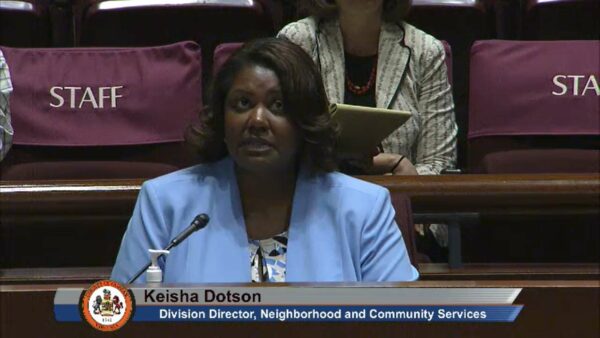
With a federal moratorium on evictions set to expire at the end of July, Fairfax County officials are preparing for a surge in evictions and accompanying demand for rental assistance and other social services.
Even with various federal and state protections in place during the COVID-19 pandemic, 599 writs of eviction and 1,411 unlawful detainers were issued to Fairfax County residents between June 2020 and 2021, according to an Eviction Data Dashboard created by county staff.
Presented to the Board of Supervisors during its health and human services committee meeting on Tuesday (June 29), the dashboard map indicates that the residents at risk of being evicted tend to be concentrated in neighborhoods of color and ones that have been hit hard by the novel coronavirus, Fairfax County Housing and Community Development Deputy Director Tom Barnett told the board.
As of June 14, residents of the 22306 zip code in Alexandria have been issued 54 writs of eviction — court notices directing the Fairfax County Sheriff’s Office to remove a tenant’s belongings from the property — the most of any zip code in the county.
That zip code has also recorded 3,641 COVID-19 cases, which translates to 11,263 cases per 100,000 people, the highest rate in the county. Within that zip code, eviction notices have been clustered south of Groveton and around Woodley Hills, census tracts with relatively high Black and Hispanic/Latino populations.
The Alexandria area in general has been particularly affected by housing instability during the pandemic with 159 writs of eviction issued, more than twice as many as any other part of the county. Falls Church comes in second with 73 writs issued.
Alexandria and Falls Church have also seen the most unlawful detainers, which are issued when a landlord seeks court assistance in removing a tenant from their property.
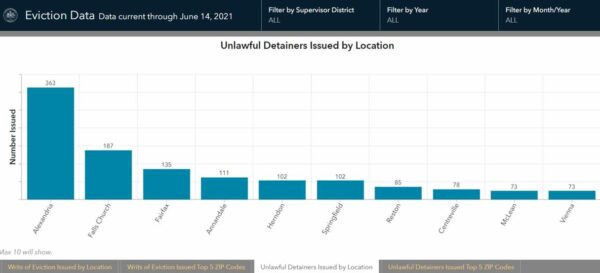
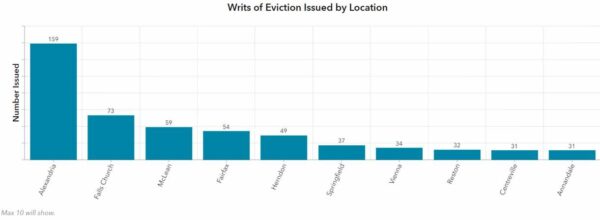
There are some exceptions to the overall correlation of eviction notices and COVID-19 cases. The 20171 zip code, which encompasses Herndon south of the Dulles Toll Road, has seen 35 writs of eviction issued — the third most in the county — but it has also reported a relatively low rate of 5,304.3 COVID-19 cases per 100,000 people.
Fairfax County Health and Human Services staff put together the dashboard using real-time information obtained from the Fairfax County Sheriff’s Office and General District Court, thanks to a partnership that the agencies formed last summer in response to the pandemic.
“We’re using this data and other data that is available to the county to target our outreach and our rental assistance,” Barnett said. Read More
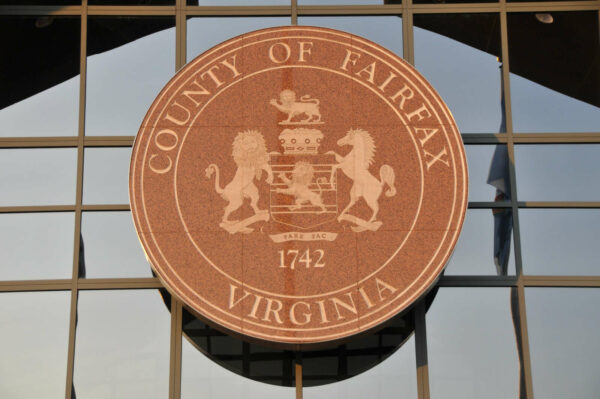
The Fairfax County Board of Supervisors is working its way toward letting public workers collectively bargain in the wake of a statewide change in 2020 to lift a decades-old restriction.
A board’s personnel committee met yesterday (Tuesday) to discuss a draft ordinance that would let Fairfax County workers make union contracts with the county government, giving them the power to negotiate pay and other benefits.
“I think we’re moving in a good direction,” Dranesville District Supervisor John Foust said after sharing concerns that the proposed ordinance might exempt too many employees from collective bargaining.
While managers, supervisors, volunteers, and other workers are slated to be excluded under the draft ordinance, the board is looking at where temporary workers such as summer lifeguards and seasonal park workers as well as non-merit employees should fall.
The proposed ordinance would serve as the framework for what can and can’t be done through collective bargaining. Once approved, it would allow workers to vote to form a bargaining unit, and employees who don’t want to be involved wouldn’t have to pay dues but could still receive the benefits of the change, Mason District Supervisor Penny Gross said.
The draft discussed Tuesday calls for collective bargaining agreements that would last three years or longer, with separate units for general government employees, police, and fire and emergency services. It also bans strikes and spells out numerous other issues.
The county’s ordinance would be separate from Fairfax County Public Schools, which has over 24,000 employees.
Gross, who chairs the personnel and reorganization committee that’s overseeing the development of the draft, said she expects the board will pass an ordinance, which could happen this year.
SEIU Virginia 512, a union that already includes over 2,000 members in Fairfax County from dues-paying maintenance workers and nurses to librarians and social workers, welcomed the board’s overall support.
But union president David Broder says the ordinance still falls short in several areas. Namely, he says it “artificially narrows” the scope of bargaining, excludes working conditions among the topics that can be negotiated, and could potentially leave thousands of workers out of the collective bargaining process.
“We’ve learned during the pandemic…that being able to bargain over working conditions is critical,” Broder said, noting the importance of safe and clean work sites, personal protective equipment availability, and scheduling.
Lee District Supervisor Rodney Lusk shared concerns about working conditions for public works and sanitation workers, expressing support for change.
Collective bargaining agreements could involve some 10,000 workers, Gross told Reston Now, and the board is gathering more information on non-merit employees to help with its determinations.
“We have one opportunity to get this right, which is why we’re taking a little extra time to work on the ordinance,” Gross said.
In 1977, the Supreme Court of Virginia ruled that public-sector collective bargaining agreements weren’t permitted and existing ones were invalid, noting the state legislature could change that.
The General Assembly and governor approved legislation last year that gave localities the authority to develop ordinances for recognizing labor unions and permitting collective bargaining. That measure took effect on May 1.
The personnel committee will meet again on July 20, and the board expects to have a public hearing in October.
via Machvee/Flickr
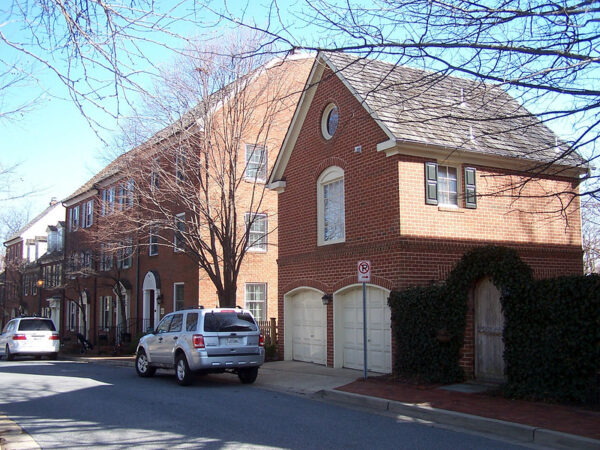
Homeowners seeking to rent out their basements or other parts of their residence as well as renters and neighborhoods concerned about parking will soon have new rules aimed at helping them.
A revised zoning code for Fairfax County, the first overhaul in around 40 years, becomes effective Thursday (July 1).
In addition to updating the county’s regulated uses with new options like live-work developments and solar farms, the new ordinance loosens some restrictions around accessory dwelling units — independent residential units that share a property with a main dwelling. But zoning officials say they expect a modest increase in homeowners converting parts of their property for other people.
Adopted in March, the new rules replace existing standards for ADUs — now dubbed accessory living units or ALUs — from 1978 and 1983, drop requirements that the occupant of the revamped space have a disability or be 55 years or older, and add parking requirements.
While the changes inspired some strong opinions from community groups, their impact is expected to be relatively small: Fairfax County approved 12 accessory unit applications in 2019, seven in 2020, and two so far this year as of Friday.
County staff previously noted there have been community concerns over whether the code is being enforced. A burdensome special permit approval process also may have been creating problems, the county said.
“Others may be installing ALUs anyway, but then perhaps they’re more likely to be unpermitted construction without the benefit of the permits and inspections,” Carmen Bishop, assistant zoning administrator, said in January before the Fairfax County Planning Commission. “So a less burdensome process may result in better compliance.”
People who have wanted such changes have had to go through a hearing, a process where neighbors could weigh in. Under the new rules, a property owner can add an interior ALU with just an administrative permit instead if they meet certain requirements.
That includes a new measure that adds an extra parking spot in off-street parking. Whether or not there’s an accessory living unit, a detached single-family house on a public street must have two off-street parking spaces or — if it’s on a private street — three off-street spots, according to the county.
“When a house has an ALU, one additional parking space will be required, which means, homes on public streets will need three off-street spaces and homes on private streets will need four off-street spaces to meet the zoning ordinance standard,” Leslie Johnson, the zoning administrator for the county’s Department of Planning and Development, said in an email Friday.
The new standards come as the county’s population exceeds 1.1 million people after rising by over 100,000 people every decade from 1980 to 2010, according to census data.
With housing prices expected to continue rising, proponents of the ALU rule changes argue that they will provide more flexibility for residents who want to stay in the county but can’t afford to live on their own.
Earlier in June, the Fairfax County Redevelopment and Housing Authority approved a change that made it easier for certain people in a first-time homebuyers program to rent a portion of their owner-occupied homes after a resident made a request.
The switch applies to 38 units and makes the authority’s policy consistent with all other units in county homebuyer programs, county spokesman Benjamin Boxer said in an email.
“Those owners may rent a portion of their home as long as they continue to occupy the property as their primary residence,” Boxer said in an email. “It is worth noting that, historically, we have rarely received any requests from our participating homeowners to rent portions of their homes.”
via BeyondDC/Flickr
Fairfax County’s once-a-decade redistricting process took a significant step forward this morning (Tuesday), as the Board of Supervisors approved appointees to a committee that will be responsible for recommending new district boundaries.
The 20-person Redistricting Advisory Committee consists of one resident representative from each of the county’s nine magisterial districts as well as three at-large members.
The county board made a conscious effort to appoint individuals from a variety of backgrounds, including people from the local African American, Hispanic, Asian/Pacific Islander, and Arab-American communities, according to the news release.
“Redistricting must be done fairly and in a way that ensures transparency and fair representation of the diversity of Fairfax County,” Board of Supervisors Chairman Jeff McKay said in a statement. “This is a community-led process, and I am confident the committee will develop fair and equal districts and everyone will have the same access to representation.”
Like other localities, Fairfax County is required by Virginia law to reexamine its electoral district boundaries every 10 years to ensure that each district has roughly the same number of people, with adjustments based on how the population has changed.
Because redistricting is tied to U.S. Census data, whose delivery has been delayed this year, the RAC won’t be able to start its work until Aug. 30. The committee is scheduled to deliver a report with its proposed district boundaries on Oct. 19, though it will ultimately be up to the Board of Supervisors to adopt a new plan on Dec. 7.
The county says members of the general public will be encouraged to provide input on the new district maps, including through an online portal that will allow residents to draw their own maps.
“Public input will be key to the committee’s efforts,” the county said. “Residents are encouraged to submit their own plans and provide feedback, revisions and comments on the committee’s or other’s proposed plans.”
The Hunter Mill District, which includes Reston, will be represented on the committee by Richard Chew, the Hunter Mill District chair for the Fairfax County Democratic Committee. He is one of seven FCDC members appointed to the RAC.
The full list of appointees, information about the redistricting schedule, and an overview of the legal criteria and policies guiding the process can be found on the county website.
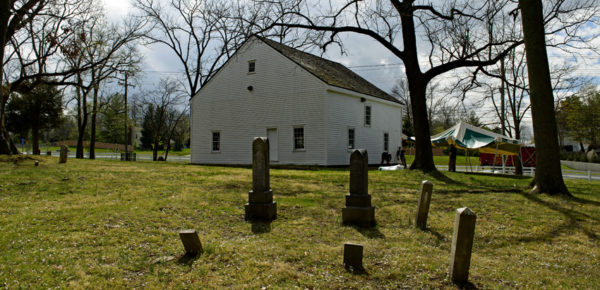
(Updated at 3:35 p.m.) For the second year in a row, Fairfax County will observe Juneteenth as an official county holiday.
The county and Virginia first recognized the occasion as a paid holiday in 2020, and the General Assembly unanimously passed legislation making the holiday permanent in October. Juneteenth will be a federal holiday for the first time this year after Congress approved a bill earlier this week.
Juneteenth falls on June 19 every year to mark the anniversary of the day in 1865 when enslaved people in Galveston, Texas, learned that the U.S. Civil War had ended and that the Emancipation Proclamation had abolished slavery almost two years earlier.
Because June 19 is a Saturday, Fairfax County will instead close government offices and give most employees a day off tomorrow (Friday). Closures include health department COVID-19 vaccination clinics, the circuit and general district courts, and Fairfax County Public Library, which will also be closed on Saturday.
The Fairfax County Department of Public Works and Environmental Services says there will be no change in its trash and recycling collection services, but county residents who utilize private collectors should contact their hauler directly to find out their hours.
DPWES offices will be closed tomorrow before reopening at 7:30 a.m. on Monday (June 21). The I-66 Transfer Station at 4618 West Ox Road and the I-95 Landfill Complex at 9850 Furnace Road will both be open tomorrow.
Reston Community Center is observing Juneteenth, but the Hunters Woods and Lake Anne facilities will both be open from 9 a.m. to 9 p.m.
Most Fairfax County Park Authority facilities will remain open with the exception of the Green Spring Gardens historic house in Alexandria and the visitor center for Frying Pan Farm Park in Herndon.
As part of a series of commemorative activities organized by the park authority, Frying Pan will host a Juneteenth celebration from 11 a.m. to 2 p.m. on Saturday with crafts, food vendors, and a talk by author Dr. Kelley Fanto Deetz, who will discuss her book “Bound to the Fire: How Virginia’s Enslaved Cooks Helped Invent American Cuisine.”
According to the Friends of Frying Pan Farm Park, the park is currently looking for volunteers to help direct parking during the event. There are eight open spots for a shift from 10:30 a.m. to 2 p.m. Volunteers must be at least 16 years old and will be provided with training and safety equipment.
Fairfax County’s celebration will also include its inaugural Juneteenth Resiliency Award to recognize people between the ages of 13 and 21 “who have exhibited true perseverance to strive towards meaningful contributions and outcomes in their lives and/or the lives of others in the Black community,” according the county news release.
The 10 award recipients will be announced during a ceremony at 7 p.m. on Saturday that will also feature remarks from Fairfax County Executive Bryan Hill, Board of Supervisors Chairman Jeff McKay, and Lee District Supervisor Rodney Lusk. The ceremony will air live on TV and online through Channel 16.
While all of its branches will be closed, Fairfax County Public Library has compiled a reading list and other educational resources for anyone interested in learning more about Juneteenth.
Photo via Fairfax County Park Authority

With federal money that gives low-income households a discount on internet service set to run out this year, Fairfax County leaders and staff are looking at ways to ensure people get access to broadband internet, which they’ve likened to a utility like electricity or water.
A staff report presented to the Fairfax County Board of Supervisors’ information technology committee on Tuesday (June 15) found that there are significant disparities in internet access among homes in the county due to infrastructure and affordability.
While different county representatives — from the school system to the Department of Family Services — were collaborating prior to the COVID-19 pandemic, they started looking more intently at equity issues during the pandemic, as technology needs hit a crescendo between students attending school from home and job seekers looking for work.
“Many of us saw at the outset how difficult it was for community members to work from home or for their children to be educated from home — whether or not they had the technology available, if they had strong enough internet connectivity, if they had space in their own homes to do this, or if they were trying to locate wireless within the community and do all of this from their own cars,” Fairfax County Public Library Director Jessica Hudson said.
Some zip codes are more affected by this lack of connectivity than others.
According to an analysis presented by the county, an estimated 4.2% of households in the county have no broadband internet access, but that number jumps up to 20.8% in the zip code 22044 and 18.8% in zip code 22041, both neighborhoods in the Seven Corners area of Falls Church.
The county estimates that 10.7% of households in north Reston (zip code 20190) are without broadband internet, along with 6.2% of Herndon residents (zip code 20170).
The gaps in connectivity are concentrated in areas with many people of color and lower-income households, Fairfax County Chief Equity Officer Karla Bruce said on Tuesday.
The Federal Communications Commission internet discount, known as the Emergency Broadband Benefit or EBB, helps lower-income households get a $50 discount each month for broadband service, among other benefits.
Officials are continuing to share information about the program, providing outreach in multiple languages and partnering with nonprofits and other community organizations.
You can still get the discount even if you have another benefit called Lifeline, which provides a $9.25 monthly discount indefinitely, Hudson said.
But the $3.2 billion fund set up to provide the EBB benefits nationwide is expected to run out this year, possibly around Thanksgiving, according to Hudson.
Among the county’s efforts to improve access, the library system offers Chromebooks that people can check out for two weeks at a time, along with extended exterior WiFi access outside buildings (except in parking garages) from 6 a.m. to 10 p.m.
In addition, Neighborhood and Community Services is conducting a countywide analysis of Wi-Fi access, and the Department of Housing and Community Development and Redevelopment and Housing Authority are conducting a site analysis to address connectivity barriers, according to the county presentation.
“All of these community agencies are trying their hardest to find ways to connect with residents and make sure that they have appropriate technology, digital literacy skills, and access points,” Hudson said.
County supervisors asked for more information to target areas in need as part of the county’s efforts to help overcome access issues.
Photo via Corinne Kutz/Unsplash

Fairfax County is slated to send additional funding to businesses that suffered the most during the COVID-19 pandemic, but a Black nonprofit says more can be done.
The Northern Virginia Black Chamber of Commerce has repeatedly been neglected in the development of major business grant programs connected to Fairfax County, the nonprofit’s executive director Sheila Dixon says.
“I would have thought we would have had the opportunity to be at the table,” she said.
The county says it’s committed to working with more than 55 chambers, including minority chambers, multicultural groups, and other community and business support groups in multiple languages with its most recent financial assistance initiative.
A working group of local minority business owners is also trying to make changes and build bridges. A webinar co-hosted by the Community Foundation of Northern Virginia on June 23 seeks to address the needs of minority-owned businesses and how they can be helped.
The group has reached some conclusions and recommendations about equitable recovery across the region and is sharing data, according to the event description. Georgetown University adjunct professor Melissa Bradley, who also co-founded a business mentoring service called Ureeka, is the keynote speaker.
The county has noted these kinds of inequities. A consultant report for the county completed in January detailed how low-income and minority households faced greater difficulties in the workforce, along with women, who have been held back by affordable child care challenges.
Those findings came from working with businesses and a roundtable of minority chambers. The Northern Virginia Black Chamber of Commerce was invited to give input and was also asked to participate in a survey about impacts and recovery, according to the county.
Fairfax County’s Relief Initiative to Support Employers (RISE) program, which gave grants to small businesses and nonprofits, dedicated at least 30% of funding to businesses owned by women, minorities, or veterans. Those businesses ended up with 72% of the approximately $53 million of RISE funding, according to the county.
“We are building on and expanding those efforts,” county spokesperson Wendy Lemieux said in an email, adding that the county is committed to extensive outreach with businesses, particularly ones owned by women and people of color affected by the pandemic.
Unlike the RISE program, the county’s new PIVOT grant program didn’t include any provisions explicitly dedicating funds to often marginalized groups when the Board of Supervisors passed it last week.
Meanwhile, the Black chamber of commerce has shared the PIVOT grant information, but it’s also continuing its own initiatives to help businesses recover from the economic effects of COVID-19.
The organization recently launched an outreach called BTRNow (Build Thriving Returns Now) that provided an online workshop for kid entrepreneurs this spring, held a “Caring through COVID” panel discussion on Monday (June 14), and is currently carrying out a listening tour, among other programming.
Dixon says a lot of the chamber’s members have pivoted amid the pandemic and have been thriving.
But she also noted that there can be disparities, and various Black businesses might be reluctant to apply for resources if they’re skeptical that the support will materialize, even if race is considered as a factor in applications.
“It will be interesting to see if people feel more comfortable,” Dixon said. “We are building up and scaling up our businesses and providing them with the education and the resources that are available within the community.”
Photo via Nathan Dumlao/Unsplash

(Updated, 12:20 p.m.) The Fairfax County Government Center, where county policy is created and official functions take place, is an imposing, modern-looking building. Above the main doors is the county seal: a royal-looking crest with lions, a horse, and the date “1742.”
Unlike the building, the seal is of a different time. Adopted seven decades ago, it bears a version of the coat of arms belonging to Thomas Fairfax, the sixth Lord Fairfax and a slaveholding British loyalist who once owned much of the land that makes up Fairfax County today.
As neighboring counties and cities reexamine their logos and symbols, it seems like only a matter of time before Fairfax County faces its own questions.
When asked if there’s been discussion about further research into the county logo, representatives of the Fairfax County History Commission said it’s not on the agenda or a priority right now.
The commission is currently undertaking an inventory of local African American history after completing one about Confederate names on public places.
Fairfax County Board of Supervisors Chairman Jeff McKay wrote in a statement to Reston Now that officials are listening to the community but have yet to hear about any issues with the county seal.
America was unfortunately built in part through the oppression of people of color. We cannot separate this history from Fairfax County, but we can listen to the community on what symbols are continuing to create divisiveness and inequity. Symbols of the Confederacy, for example, do not speak to the County’s values today, so we are working to remove these through the proper processes. Currently, there are ongoing efforts to change road names as well as other Confederate symbols and the Board previously took action to remove the monument of John Quincy Marr from the courthouse. We have not heard from our community members that these same messages are felt from the County seal. We continue to invest significant resources into our historically underserved communities to ensure that everyone has the opportunity to thrive in Fairfax County.
The county selected the seal as its logo in 1949 ahead of an impending visit from the then-Lord Fairfax. It won over a dozen other seals belonging to the Fairfax family due to “its clarity when reproduced,” according to historical documents from Fairfax County Public Library’s Virginia Room.
A county flag with the seal was unveiled on June 13, 1968, the day before Flag Day, in response to repeated requests for a flag from county schools.
“We probably ought to have a Betsy Ross here to get the flag ready for Flag Day,” said Gil Shaw, the flag’s creator and the county’s director of information services at the time. “But the coat of arms of Thomas Lord Fairfax will soon fly over the lands he once owned and which became Fairfax County in 1742.”
Early colonial Virginia land history is admittingly a bit confusing due to the limited availability of written records and a lack of variety in names.
“The famous one, for our purposes, was the sixth Lord Fairfax,” explains Steve Harris-Scott, an assistant professor in George Mason University’s history department and an expert on colonial Virginia history.
“The nobles generally passed on their names to their first-born son, so when they took over the title, they were all the same names,” he said. “There was a Thomas Fairfax, first Lord Fairfax, then there was Thomas Fairfax, the second Lord Fairfax, etcetera.”
The sixth Lord Fairfax was born in England in 1693 to the fifth Lord Fairfax and Catherine Culpepper.
Through his mother’s side, he inherited about 5 million acres of land in 1710 known as the “Northern Neck,” which encompassed today’s Fairfax County. Taken from the indigenous people who had lived there for centuries, the land was a gift to Catherine’s father, Thomas Culpepper, from the restored King Charles II for his support during the English Civil War.
“[This land] is essentially bordered by the Rappahannock [River] on the south and the Potomac on the north,” Harris-Scott said.
However, Fairfax spent most of his life in England and didn’t move to Virginia until 1742, the date on the county’s logo. He also may never have resided in what is now Fairfax County, according to Harris-Scott. Read More

Arts organizations, museums, and hotels are some of the key targets for Fairfax County’s new initiative to get money to those in need, and informational sessions are providing help.
Approved by the county board last week, the PIVOT program will provide financial grants to small businesses as well as other recipients, and webinars about the effort will begin at 1 p.m. tomorrow (Tuesday) in English and at 2 p.m. Thursday (June 17) in Spanish.
Links to the webinars can be found on the Fairfax County Department of Economic Initiatives website.
“Fairfax County is committed to helping businesses recover from the effects of the pandemic,” Board of Supervisor Chairman Jeff McKay said in a news release. “Through the PIVOT grant we will help those businesses who saw the greatest financial impact regain their momentum so they will be able to thrive in the reopening marketplace.”
Federal funding through the American Rescue Plan Act is supporting the program with $25 million to the county.
Applications can be submitted online through a grant portal that will be open from June 23 to July 9. The money is being administered through the nonprofit Latino Economic Development Center, said Rebecca Moudry, director of Fairfax County Department of Economic Initiatives.
The areas targeted will give relief to food services, lodging, retail, services, amusements, arts organizations, museums, and historical sites.
Potential monetary awards for individual businesses and nonprofits include the following:
- $18,000 for restaurants with less than $3.5 million in annual receipts or gross revenue per establishment
- $12,000 for retail, services, and amusements with less than $3.5 million in annual receipts or gross revenue per establishment
- $10,000 for large arts organizations, museums, and historical sites with annual receipts or gross revenue greater than $100,000
- $5,000 for smaller arts organizations
- $1,500 for food trucks that don’t belong to a restaurant
- $400 per room to hotels with a minimum of 10 rooms
The money will go to businesses that have no more than 500 employees, among other criteria. Nonprofits don’t have an eligibility restriction regarding the number of workers they have.
The new outreach comes after the county ended its Fairfax Relief Initiative to Support Employers (RISE) program last year, distributing around $53 million, one of several financial outreaches by the county.
The PIVOT grants will go to hotels first, then to other organizations if demand is too great. The county could also add to the funding in the future.
Photo via Clay Banks on Unsplash
The Fairfax County Democratic Committee wants county leaders to fire newly hired county Police Chief Kevin Davis in response to continued controversy surrounding his history as an officer.
The local political group passed a motion at its general membership meeting yesterday (Tuesday) recommending that the Fairfax County Board of Supervisors fire Davis, reopen the police search, and implement a transparent hiring process.
“We believe we need to overhaul the criminal justice system from top to bottom, to end racial inequity in policing, end police brutality and build a police force built on trust where our residents don’t need to worry about protecting their families from the police sworn to protect and serve them,” FCDC said.
Davis’s hiring has drawn vocal criticism from civil rights advocates and community groups since he was appointed as retired Chief Edwin Roessler’s successor on April 23, particularly in the wake of an NBC4 report on two lawsuits that he faced while working as an officer in Prince George’s County, Maryland in the 1990s.
In one case, Davis reportedly stopped and violently arrested a driver, eventually leading to a $12,500 jury award to Mark Spann, who is Black. The other case involved Davis and a group of narcotics officers illegally detaining a 19-year-old, who later sued and won a $90,000 judgment.
Davis has also faced renewed scrutiny for his 2015-2018 tenure as commissioner of the Baltimore Police Department, which included a secret aerial surveillance program and a six-day lockdown of the predominantly Black Harlem Park neighborhood that is the subject of an ongoing lawsuit filed by the ACLU’s Maryland chapter.
“Hiring a candidate with a history of racially charged use of force incidents in their past is not starting from a place where community trust can be built,” FCDC said.
Board of Supervisors Chairman Jeff McKay has repeatedly expressed confidence in Davis as Fairfax County’s new police chief.
A spokesperson from his office declined to comment on the FCDC motion, which was developed by the committee’s Black caucus. The committee says in a press release that it was “overwhelmingly” supported by its 1,000-plus members.
In lieu of a comment, McKay’s office shared a letter sent to FCDC on May 20 that touted Davis’s “ability to implement progressive reforms,” citing his efforts to implement changes in Baltimore like the introduction of body-worn cameras and a revised use-of-force policy that emphasizes deescalation.
The letter, which was signed by all nine Democratic supervisors, also defended the level of public engagement used during the police chief hiring process. The search included a pre-screening panel, a survey that generated over 3,000 responses, and an outreach campaign with over 275 community meetings and calls.
Davis also participated in a public input session during his first week as the new police chief — albeit with continued controversy.
“We are confident that this year’s process was the broadest and incorporated both extensive public input and intentional inclusivity,” the Board of Supervisors letter said. “Regardless, we commit to looking at our entire public participation process for future personnel decisions and establishing a framework for further improvement.” Read More


